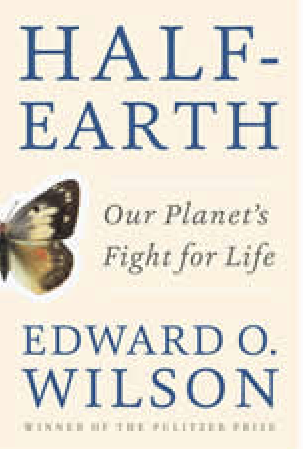By Stuart Pimm, E.O. Wilson Biodiversity Foundation Board of Advisors
Originally published in Nature, 531, March 10, 2016
“Conservation: Glass Half Full”


What do humans want? So asks E. O. Wilson near the start of Half-Earth, his bold vision for the biosphere. He outlines the probable answer: “indefinitely long and healthy life for all, abundant sustainable resources, personal freedom, adventure both virtual and real on demand, status, dignity, membership in one or more respectable groups, obedience to wise rulers and laws, and lots of sex with or without reproduction.” He adds: “These are also the goals of your family dog.”
The eminent biologist demands that we aspire to much more. He calls for no less than committing half of the planet’s surface to a haven for nature. It’s an ambitious goal, yet failure would be dire.
This is no isolated argument. Half-Earth is the last in a trilogy. In The Social Conquest of Earth (Liveright, 2012), he marvels at how advanced social organization is rare among animals and how “one species of large-sized African primate” — us — has become not merely dominant, but a force of geological change. In The Meaning of Human Existence (Liveright, 2014), he argues that we are “a biological species in a biological world,” adapted to going forth and multiplying as if there were no tomorrow. There might not be. Only if we protect ‘Half-Earth’ can the vast majority of species can be saved.
“We must articulate an endpoint beyond saving particular species and habitats.”
Wilson’s vision begs questions that he does not address in detail. Is it feasible? How close are we to achieving it? In which ecosystems — forests or deserts or reefs — might we succeed? Where might failure be inevitable? Instead, he presents a manifesto. Half, he says, is a safe limit, because our own survival depends on the services of nature. Wilson argues a psychological need, too. He intends his goal to inspire us to strive nobly against the odds on behalf of all life. We must articulate an endpoint beyond the day-to-day business of saving particular species and habitats.
The consequences of protecting less than half are as close as my local supermarket on Key Largo, Florida, where I do my fieldwork. It is 500 metres from the Atlantic Ocean on one side and the Gulf of Mexico on the other, yet the fishmonger’s slab is covered with farm-raised salmon and tilapia, and scallops from the Southern Hemisphere. Even the mahimahi — available locally — is from Mexico.
Wilson castigates those who think that there is no problem with humans eliminating species 1,000 times faster than the natural background rate. Will new species evolve as they did after the mass extinction that killed the non-avian dinosaurs? It took evolution 5 million years to restore previous levels of diversity. Will invasive species fill in the gaps? Alien species from rabbits in Australia to zebra mussels in the United States already cause harm costing billions of dollars per year.
Nor is Wilson kind to “new conservation,” a movement that he notes is embraced by the large US land trust the Nature Conservancy. Its proponents denigrate those who believe in pristine landscapes and, as he puts it, “prefer ‘working landscapes’ presumably as opposed to ‘lazy and idle’ landscapes, thereby making them more acceptable to … business leaders.” A Google search suggests that the term pristine landscapes may have appeared in the flagship journal Conservation Biology once in the past decade — raising the question of who the professionals are who supposedly believe in them.
The Amazon exemplifies what Wilson calls wilderness: regions with small human populations, mainly indigenous ones. Companies that extract resources have historically been insensitive to the cultural disruption, and even genocide, that this can trigger. Wilson emphasizes how cultural diversity and biodiversity are important and can reinforce each other. I share his impression that the individuals most uncaring and dismissive of wilderness and biodiversity are those who have had the least experience of it. As nineteenth-century explorer Alexander von Humboldt put it: “The most dangerous worldview is the worldview of those who have not viewed the world.”
Is Half-Earth possible? The trajectories are favourable. About 5 million square kilometres of land and almost none of the oceans were protected in the mid-1970s; now the figures are close to 17 million and 10 million square kilometres, respectively. Vast marine no-take zones have been established annually since 2000. Globally agreed targets aspire to more, and more representative, protection. Large tracts of land — deserts, the Amazon, the boreal forests — are protected because they are remote. The challenge will be to protect areas near cities, or areas that, like temperate grasslands, are easy to convert to livestock grazing.
A change in moral reasoning gives Wilson most hope. A 2015 encyclical letter from Pope Francis contains an outstanding tour of the challenges in mitigating damage to natural habitats. Its moral imperative, that we have no right to do harm, echoes Wilson’s concluding sentence: “Do no further harm to the biosphere.”
Wilson lauds those who devote their lives to that cause. The degraded longleaf-pine savannahs of the US Gulf coast — neglected by federal authorities and land trusts — found a champion in the philanthropist M.C. Davis. Entrepreneur Greg Carr has helped to restore Gorongosa National Park in Mozambique after a brutal civil war. Entrepreneurs Douglas and Kristine Tompkins have protected more land worldwide than any other private individuals — and in temperate grasslands, to boot. Progress on Half-Earth is possible in unlikely places. It is an aspiration worthy of our species.

